|
Welcome to GW's Ethanol Projects page.
The basic tale is this: A fellow in Texas, (GW, of course), got tired
of waiting for somebody to do something about a lack of alternative fuels. When E-85 ethanol
fuel became available in his area (finally) last year, he began experimenting with it. This
E-85 is sold at a Waco, Texas, HEB store. It is priced 30 cents per gallon cheaper than
gasoline, typically.
Since October 2006, his old 1944 farm tractor and an old-time 1973 VW “beetle” have run on E-85 ethanol,
and he did the conversions himself for no money out-of-pocket. It would take some labor,
similar to that of an afternoon with a qualified mechanic, to do the conversions as currently embodied.
The experimentation took longer, because carburetion is much more a black art than it is a science.
Both the tractor and the car run sensibly better on ethanol than on
gasoline. There is data on the car to prove this beyond any
doubt. The efficiency improvement offsets some of the lower
energy content of the E-85, so that mileage, while lower, is better
than the experts typically tell you. There have been no materials
compatibility problems at all with these vehicles. The engines
actually run cleaner on the inside, which foretells longer life in a
new vehicle.
GW got his “black-art” carburetor conversion “just about right” for very cold weather on the Ethanol VW.
His fuel injected truck is being used to test blends in unmodified modern vehicles. His unmodified 4-stroke
lawn and garden equipment is also running quite well on blends.
Lessons learned so far: This stuff really works. It really, really works quite well.
We Americans will need more ethanol so that more people can do what GW has done.
He feels very good knowing that 85% of the fuel he burns does not come from the Middle East and their
way-too-closely-associated major oil companies. The other 15% could come from all-domestic oil only.
Further, it is possible to do without that 15%. Just use a small start canister, as in the
ethanol aircraft work GW did while working at Baylor University.
We Americans will need a lot more ethanol than can be made from corn. Ethanol-from-corn
already eats up about 20% of our total corn crop, and that’s already way too much. Yet to
replace gasoline, we would need about a hundred times more ethanol than there is right now.
We will need sugar cane, and most especially, ethanol from waste, weeds, or energy-crop cellulose conversion.
Related links and more information:
GW has a PowerPoint briefing on his ethanol vehicles projects. He
has given this presentation to civic and church groups, and anybody
else who might listen. It has always sparked much discussion
among those who have seen it. To see an early version of it for yourself, click
here: Ethanol Vehicle Slide Show.
GW keeps a lot of data and records on his ancient VW. Being an engineer, he analyzed
these data very carefully to show real, traceable results. For the initial round of the
ethanol VW testing, there is a short report full of mileage results and the direct fuel cost
economics. This report includes the effects of his not having done the cold-weather
air preheat correctly during that study period. To read it, click here:
Ethanol VW Report 21.
The ethanol VW is a very old, very high-time machine, very near the end of its life.
This is true for both its engine and its transmission. One of GW’s reports documents
the gasoline baseline, and discusses these old age effects in a machine losing compression and
oil control before the ethanol experiment ever started. Click here to read it:
Ethanol VW Report 11.
On advice from his friend and partner in the cactus-killing business, GW made some changes in
lubricant blends that seem to have helped greatly with the compression and oil control problems
in the old, worn-out ethanol VW. The fuel odor in the engine oil (from blow-by gases)
went away, as did the baked-on oil sheen on the spark plug rims. Compression tests show
considerable improvement in the dry-test readings. The ethanol seems to have cleaned
up a lot of the routinely-expected sooting on the spark plugs. This portends longer
life for new vehicles using ethanol fuel, because there is almost no carbon "grit" getting into
the lube oil from the flame soot. GW documented these beneficial effects in a tuneup
report. To read it, click here: Ethanol VW Report 22.
Basically, the “ethanol VW” experiment is complete: As a
“daily driver” commuter car, it just routinely runs on E-85. Long-term
surveillance is important, however, because many still claim this fuel
does harm to engines and fuel systems. GW has written two
reports documenting how well the old VW has held up since making the
changes to fuel and lubricant blend. Click the first
(Ethanol
VW Report 31) to see how well the carburetor has held up. Click
the second (Ethanol
VW Report 32) to see how well the engine has held up, and what the
long term trends of mileage and efficiency have been. This second report
also draws some indirect conclusions regarding exhaust emissions. These
emissions findings directly contradict the reasons given by the EPA
for its opposition to gasohol blends stronger than E-10.
The oil additive GW used was Lucas Oil Stabilizer. This is a polymeric additive similar to
the materials used for synthetic oils. It even quieted somewhat the age-related noises
in the VW’s transmission. He also has successfully used it to control an irritating oil
leak in EJ’s Nissan, making a power-of-10 difference in the leakage rate. To learn more
about engines, lubrication, and motor oil for yourself, click here:
Educational Services.
To find out about start canisters and using neat ethanol or simple denatured ethanol, or about using
ethanol fuels in aircraft, click here: Aeroconsulting Page.
To find out more about what ethanol fuel is, and what its properties are, click here
Ethanol Fuel Information.
GW’s 1995 fuel-injected Ford F-150 truck runs just fine on ethanol blends
anywhere between 15% and as high as 42% in the summer, 35% in the winter. Click
here to access the results in
Ethanol Ford Report 8. He recommends a max of E-35 for
every car in the gasoline fleet, based on his experiences with this
truck, and with his 4-stroke lawn and garden equipment. The
lawn and garden equipment includes two lawn mowers, a wood chipper,
and a tiller, all running completely unmodified on E-34.
That blend is very easily made as two gallons of E-85 with 3 gallons
of unleaded regular in a 5 gallon can. GW estimates the
pump octane of E-34 blend as 95 or 96 octane, way better than premium.
(Even an E-20 blend could replace premium at 93 octane.)
|
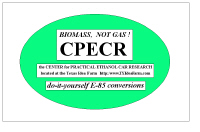

GW in the ethanol VW - 2006

GW on the 1944 ethanol Farmall
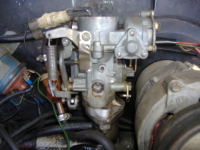
Ethanol cleaned the old gasoline deposits
off this VW carburator
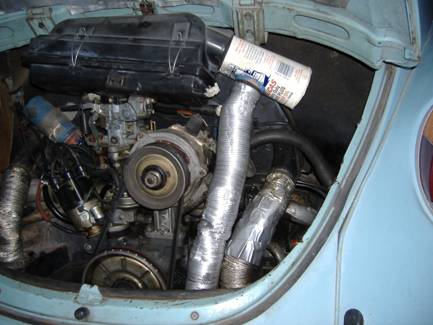
Latest air intake rig for handling cold weather
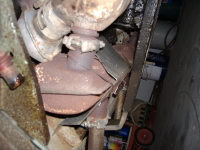
Sheet metal glove on muffler creates warm intake
air in cold weather
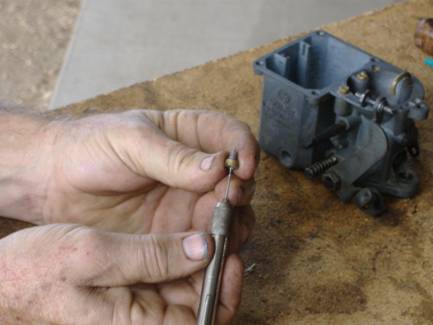
Drilling out a carburetor jet for ethanol operation
|









